#Virginia and Albert Museum
Explore tagged Tumblr posts
Text
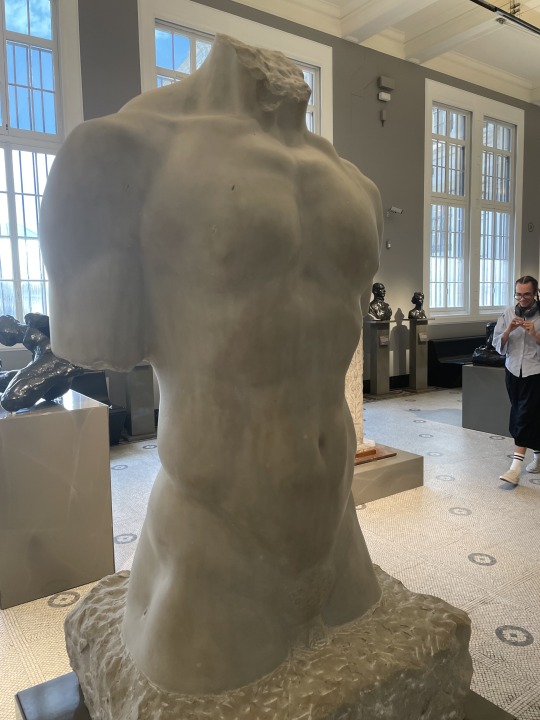
#statue#marble#Torso of Banovic Strahinja#Ivan Mestrovic#Serbian folklore#Virginia and Albert Museum#London#England
8 notes
·
View notes
Photo

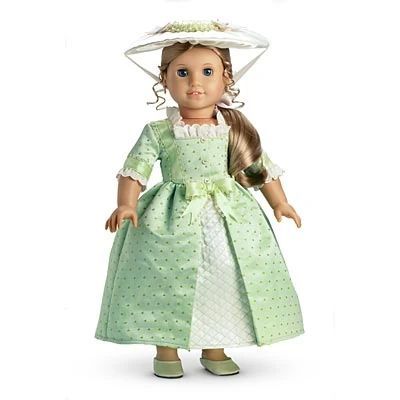

The fashion nerd in me is utterly thrilled by Felicity’s summer dress. This style of lightweight white cotton dress was eventually referred to as a chemise à la reine, after Marie Antoinette was painted (and immediately hated for) wearing one.
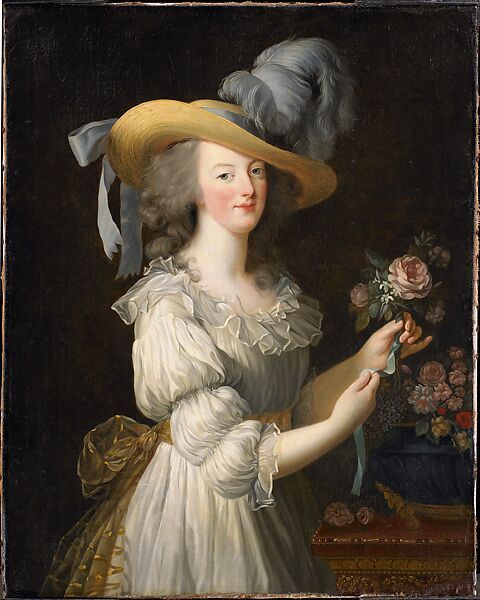
This style only really became popular for adults in the 1780s, but in the 1770s, it was popular summer-time wear for girls.
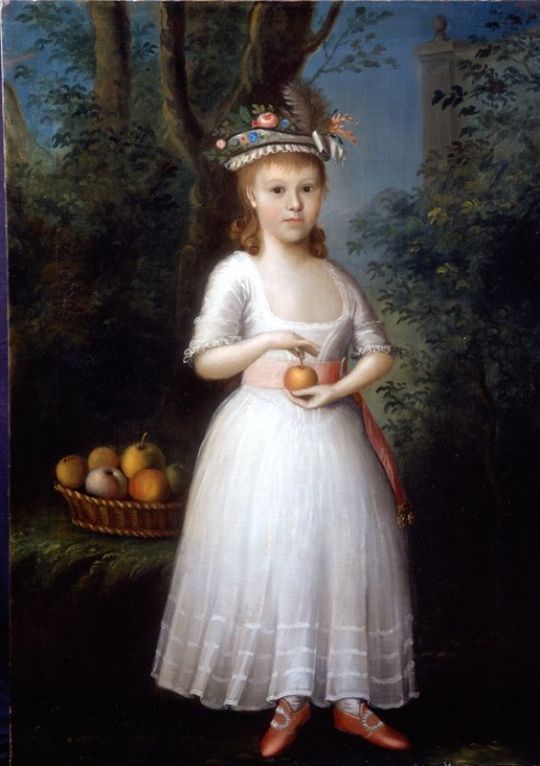
There’s not a whole lot to say about Elizabeth’s dress, it’s again pretty accurate and appropriate for her social status.
The straw hats are not simply straw hats. The proper name for that style is bergère, or shepherdess. They were pretty essential outdoor wear for proper ladies who wanted to protect their fine pale complexions.

(Kerry Taylor Auctions)
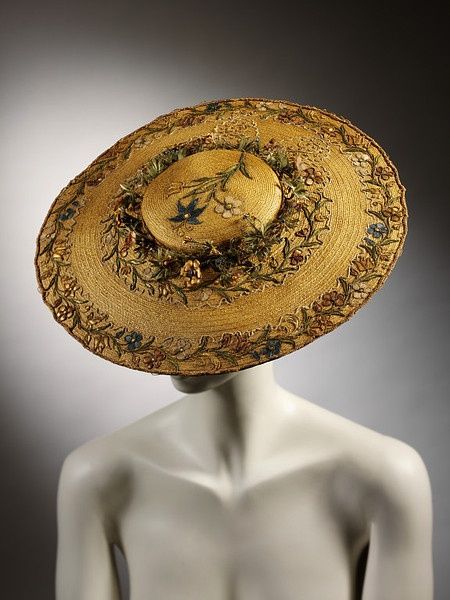
(The Victoria & Albert Museum)
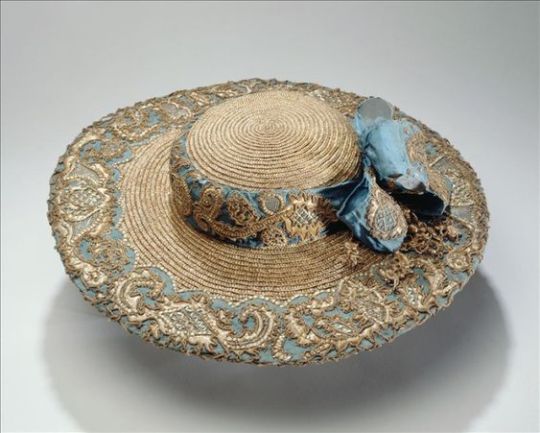
(Musée Galliera de la Mode de la Ville de Paris)
Finally, I kind of feel the need to address what’s the elephant in the room when it comes to Felicity:

Everyone was acting all horrified and outraged by this, but, well.... have I got news for you about middle-class white families in Virginia in 1774. It would be very inaccurate for them to not have slaves.
If we want to get technical, Felicity herself never actually owned slaves. Her father owned a couple of slaves, and her grandfather owned a plantation. When her grandfather died, the plantation would have gone to her father, and then down to her little brother, William. Felicity likely would have grown up to marry a man who owned slaves, but she still wouldn’t own them outright herself. All that being said, there were special no-male-heir circumstances in which women could inherit property, and there absolutely were woman slave-owners out there.
Slavery is a part of American history and honestly it does us more of a disservice if we try to cover it up. The fact that Felicity’s family owns slaves is a great chance to teach kids about the big, messy questions of history. Kids are smart and capable of understanding complex historical issues. They deserve to know this kind of shit.
558 notes
·
View notes
Text
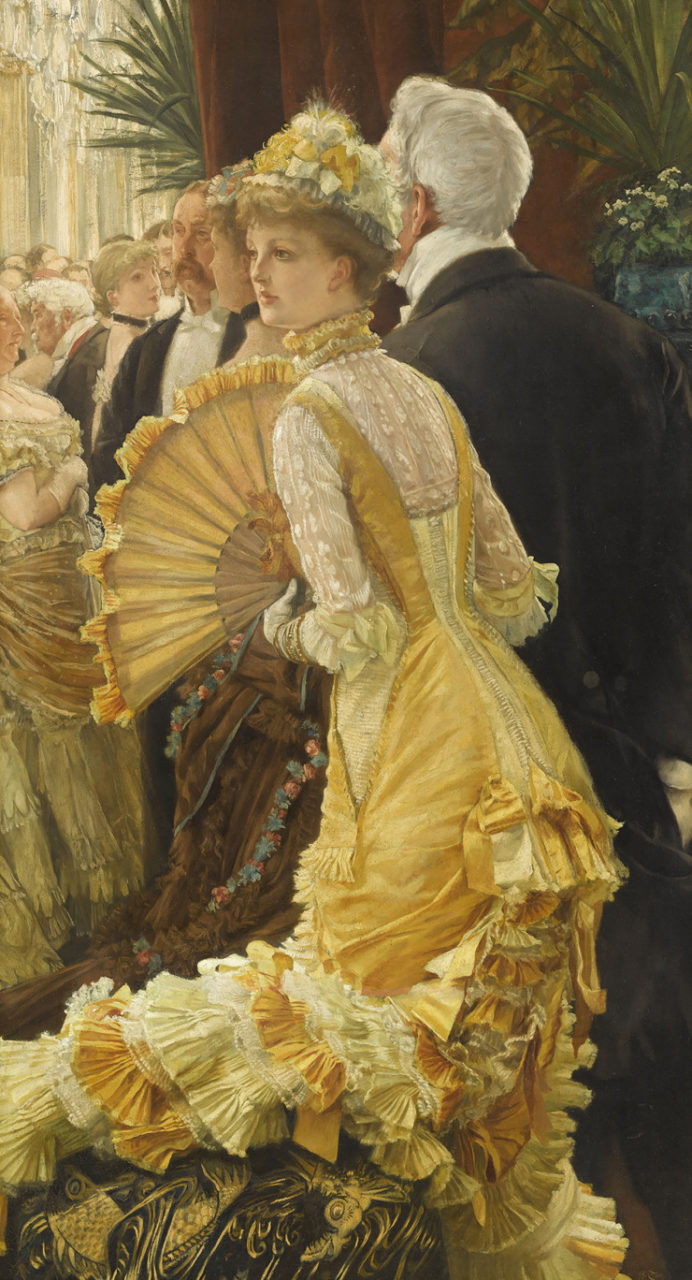
figure 1
James Tissot (French, 1836–1902) • The Ball • 1878
Figure 1: According to French fashionistas, Tissot got the hat all wrong. Apparently hats were inappropriate as evening wear, particularly at a ball. Indeed, when perusing fashion plates of the late 1870s, formal evening attire never included hats.
For formal evening events, hair was styled in elaborate braids, buns, and curls, often adorned with silk flower sprays and fancy clips and combs. Silk flowers were also sometimes used as embellishments for dresses.
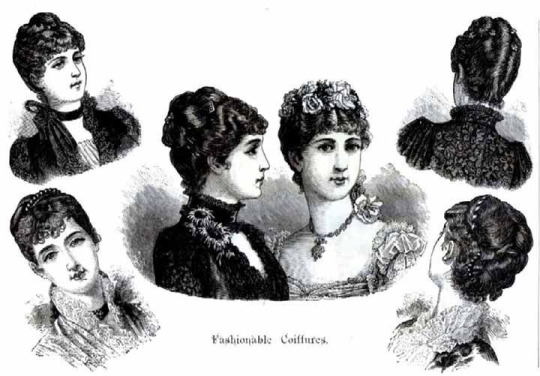
A Tissot creation likely inspired by the fashion plates of the day, the evening or ball dress in figure 1 features a bow right at the buttocks followed by a cascade of layered pleats, lace, and ruffles. This style was commonly referred to as The Princess Line dress. Created in Great Britain by Charles Frederick Worth in the form of Princess Alexandra's wedding dress, it soon took off as the latest dress style craze.

French hand fan • Ivory, paper, gouache, mother-of-pearl, metal • 1860-70 • Brooklyn Museum Costume Collection at The Metropolitan Museum of Art
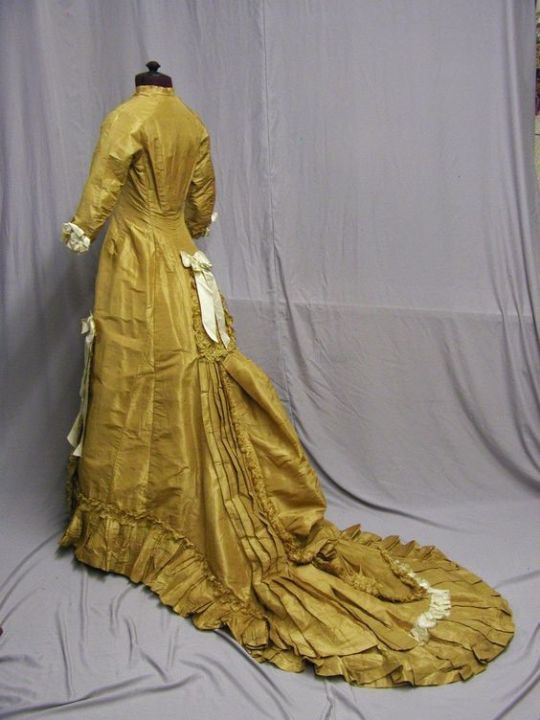
Figure 2
Figure 1: In the mid 1870s, the bustle evolved into a less protruding fashion feature and eventually, toward the end of the decade gave way to the mid-bustle or natural form era. This transformation took place from 1877 through approximately 1882. Compared to the large, overstuffed bustles of the early 1870s, the Mid-Bustle, or Natural Form dress created a more vertical, slimming silhouette. The waist was undefined and embellishments began at the back of the waist, or even below it.
Figure 2: It is difficult for a fashion history novice like me to define the correct occasion for this particular dress. It's perhaps a special occasion day or afternoon dress and hence less embellished. Or perhaps the modest satin bow at the hip gives it away as just a regular day dress. In one entry at Lily Absinthe's blog, she states that a semi-train is usually indicative of a day or afternoon special occasion dress. All I know for sure is that I adore the lovely vertical pleated train!

Princess Line dress • 1878-1880 (made) • Unknown designer and maker, likely from Great Britain • Virginia and Albert Museum
Blue and gold Jacquard-woven silk made with a fitted bodice and narrow skirt drawn back into drapes at the back, and rusched silk trim. It has elbow-length sleeves and a square neckline, which are both trimmed with machine-lace. This is a day or afternoon dress, likely worn at home. More views of this dress can be seen here.

Attire appropriate for a hat.
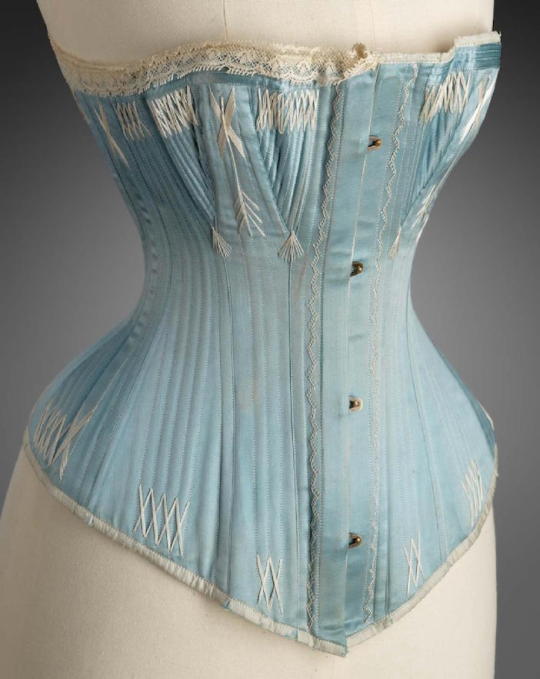
Of course, the ultra-slim silhouette of the princess dress was restrictive and necessitated increasingly tighter undergarments like corsets and girdles, further restricting movement. Poor working women who engaged in hours of manual labor could not afford either the latest fashions nor the restricted movement.
Sources:
Lily Absinthe
The Metropolitan Museum of Art Costume Institute , New York City
Fashion History Timeline (FIT, Fashion Institute of Technology, New York City
V & A (Victoria & Albert Museum, London
#fashion history#late 1870s fashion history#princess line dress#james tissot#art history#french fashion history#late 1870s fashion plate#french hand fan#victorian fashion#historical fashion#victorian era#19th century fashion#the resplendent outfit blog#french fashion#historical painting
78 notes
·
View notes
Text

Beatrix Potter (British, English ) • The Rabbits' Christmas Party (generic title) • Drawing: watercolour and pen and ink over pencil on paper • 1892 • Virginia and Albert Museum, London
This drawing is one of a narrative series of four finished watercolours in the Linder Bequest known as ‘The Rabbits’ Christmas Party’.
For dessert, the rabbits roasted apples. They tied apples to strings and hung them by the fire. The rabbit who watched them used a cabbage leaf to keep her face from getting too hot. After all of the food and exercise, some of the rabbits had trouble staying awake around the warm fireplace.
– Excerpt from The Rabbit's Christmas Party
#illustration#art#illustrator#beatrix potter#british#19th century illustration#christmas illustration#watercolor illustration#pen & ink#book illustration#Illustration blog#sassafras & moonshine blog#artist#children's book author#children's book illustration
86 notes
·
View notes
Text
Day 7. Monday Sept 11, Post I of II: Washington DC. OMG, I have long wanted to visit DC, and now I know why. This place is a goldmine of landmarks and history.
I start off the day buying a hop on hop off bus tour ticket and walking downtown to the nearest stop. As I wait for the bus, I realise that I am across the street from the Ford Theater where Lincoln was assassinated and in front of the Peterson House where he was taken for treatment but unfortunately died.
Looking to cheer up I hop on the bus which has justcartived. Simply speaking, Washington DC is aligned north to south with the Potomac River running along the west side and the National Mall running east from the river for about two miles, parallel to Constitution Ave.
At the far west end of the National Mall, overlooking the river and the Arlington Memorial Bridge stands the Lincoln Memorial. If you go west and cross the river, you are in Virginia and at Arlington Cemetery. This 269-acre national site holds over 400,000 graves, including JFK and Jackie Onassis and the Tomb of the Unknown Soldier. I also happened to trip over Robert McNamara's tomb stone.
Meanwhile, back in DC, if you look east from.the Lincoln Memorial down the National Mall, you see in sequence the Reflecting Pool, the WWII Memorial, the Washington Monument and far in the distance the US Capital. About one third if the way down, immediately to the left (north) of the Washington Momument, sits the White House.
Washington DC is chock full of significant historical buildings. Rather than trying g to recreate my route, let me just run down what I saw and remember:
Fords Theater
The White House
The Willard Hotel, located near the Whitehouse, it was a prime location for dignitaries. It is rumored that those wishing to petition their causes would often wait in the lobby, hoping to bump into their intended targets, thus begat the name lobbyists.
The FBI building where J Edgar Hoover ruled from 1935 to 1972.
The US Capital
US Treasury
Library of Congress
The original US Post Office, now a Waldorf Astoria Hotel
Numerous Smithsonian Museums, all free
L'Enfant Plaza
The International Spy Museum
Washington Monument
The Holocaust Memorial
Jefferson Memorial
FDR and MLK Memorials
Lincoln Memorial
Albert Einstein Memorial
Arlington Cemetery
WWII Memorial
The National History Museum
The Bureau of Engraving and Printing where paper mo ey is printed (as opposed to the mint which strikes coins).
There was more, but for now, that's all I can remember, and you get the picture.
The highlight of the day, however, turned out to be my trip to The Capital. Following a structured tour where I saw the inside of the rotundra and the original meeting rooms for the House and the Senate, I was permitted as a visitor to the US to witness a vote in the Senate. They were not actually sitting in session, so I sat there for an hour while the senators dropped by to vote. I didn't know many of them, among those I did see and recognize were:
Cory Booker
Susan Collins
John Cornyn
Ted Cruz
Dianne Feinstein
Chuck Grassley
Amy Klobuchar
Lisa Murkowski
Mitt Romney
Marco Rubio
Bernie Sanders
Chuck Schumer
Kirsten Sinema
Tommy Tuberville
Elizabeth Warren
It was quite the day. I walked back to my hotel in the Union Market area through the gentrifying areas to the north and east of the historic downtown core area I'd been prowling. DC's population is currently circa 720,000, but it is clearly growing and expanding.






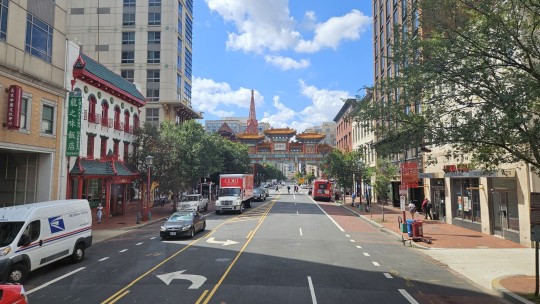



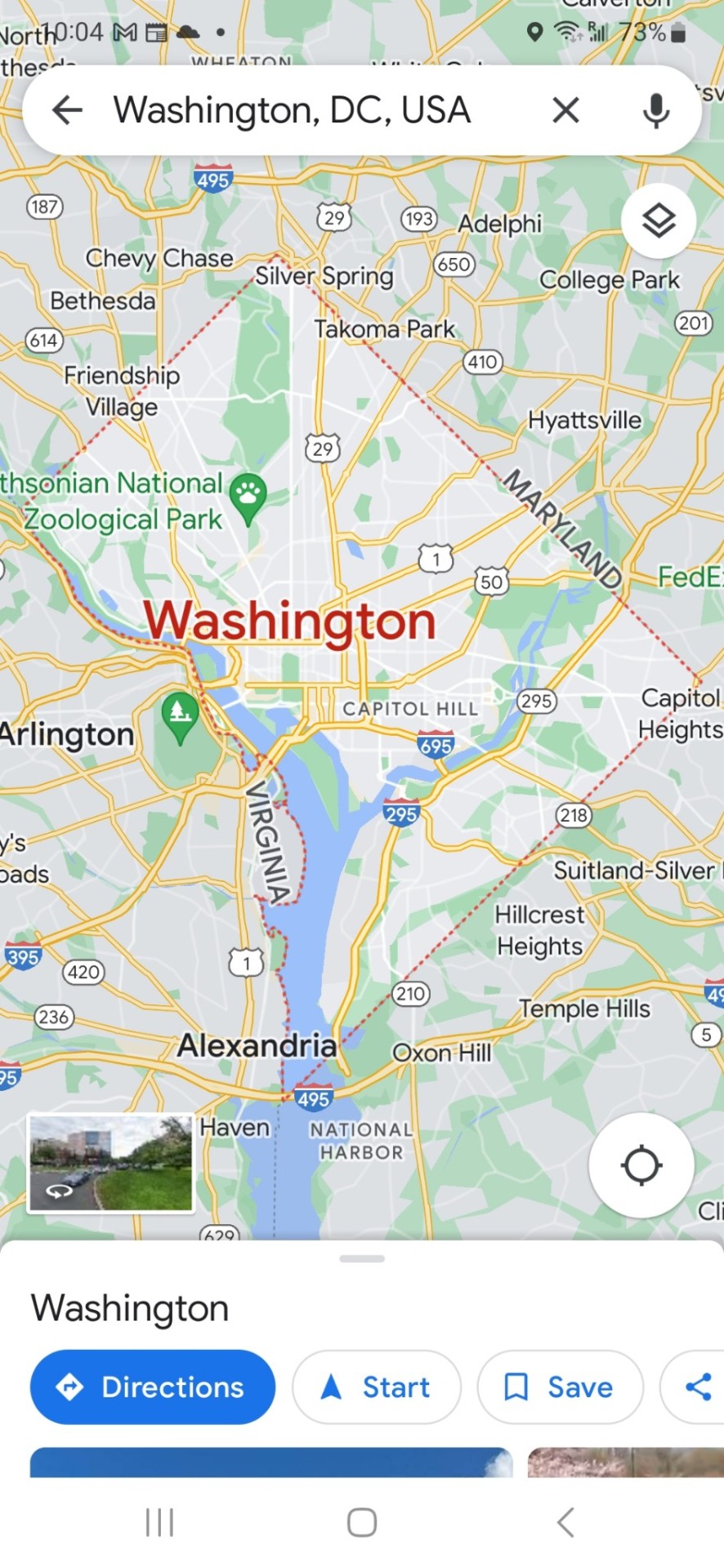
0 notes
Photo

Dior
#Dior#Gemma Arterton#Christian Dior#London#Victoria & Albert Museum#V&A#Summerland#Murder Mystery#My Zoe#Vita and Virginia#2019#Neutrals#Nude Tones
30 notes
·
View notes
Text
Civil War in the Kanawha Valley: Morgan Kitchen Museum (2019)
Civil War in the Kanawha Valley: Morgan Kitchen Museum (2019) #CivilWar #SaintAlbans #KanawhaCounty #WV #history #MorganKitchenMuseum


Terry Lowry is THE authority on the Civil War in the Kanawha Valley. Stop 8 on his tour: Morgan Kitchen Museum in Charleston, WV. 29 September 2019. Here is a link to Terry’s latest book, The Battle of Charleston (2016): https://wvcivilwar.com/now-available-the-battle-of-charleston/

Morgan kitchen was built in 1846 near the present-day location of John Amos Power Plant. During the war, the…
View On WordPress
#Albert Sidney Johnston Morgan#Appalachia#Battle of Charleston#Battle of Scary Creek#civil war#history#Jacob D. Cox#John Morgan#Kanawha County#Morgan Kitchen Museum#St. Albans#Terry Lowry#Union Army#West Virginia
0 notes
Photo
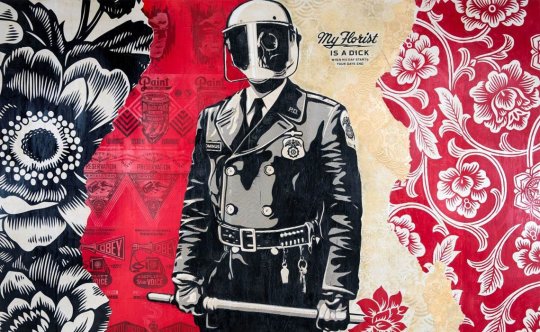

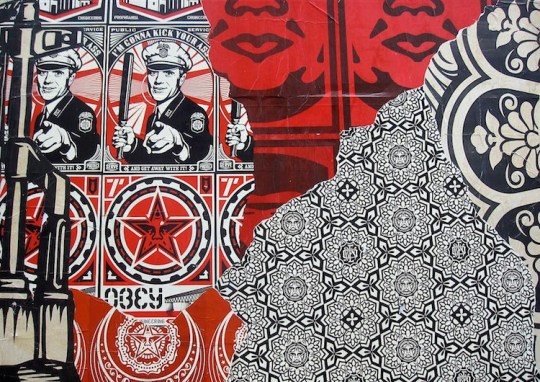

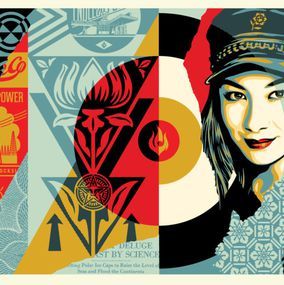
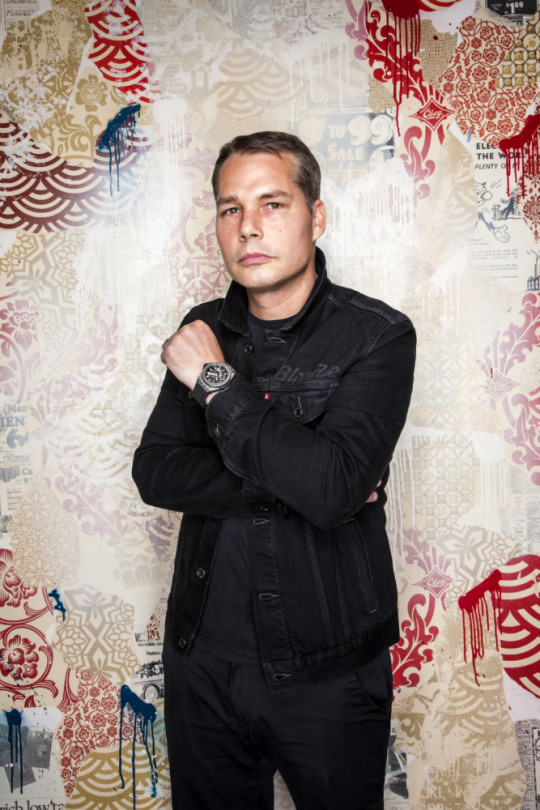
Shepard Fairey (born 1970) is an American contemporary artist, activist and founder of OBEY Clothing who emerged from the skateboarding scene. In 1989 he designed the "Andre the Giant Has a Posse" (...OBEY...) sticker campaign while attending the Rhode Island School of Design (RISD).
Fairey designed the Barack Obama "Hope" poster for the 2008 U.S. presidential election .
The Institute of Contemporary Art, Boston has described him as one of the best known and most influential street artists. His work is included in the collections at The Smithsonian, the Los Angeles County Museum of Art, the Museum of Modern Art in New York City, the Museum of Contemporary Art San Diego, the National Portrait Gallery in Washington, D.C., the Virginia Museum of Fine Arts in Richmond, and the Victoria and Albert Museum in London.His style has been described as a "bold iconic style that is based on styling and idealizing images."
https://en.wikipedia.org/wiki/Shepard_Fairey
3 notes
·
View notes
Text

(Image)
✒️ 𝓛𝓲𝓽. 𝓟𝓸𝓼𝓽𝓼
Pride & Prejudice (2005) vs My Photos of the Statue Gallery at Chatsworth House (2018) & Chatsworth House (2024)
John Milton’s Cottage: Museum Photographs & the William Blake Illustrated Edition of Paradise Lost
Wordsworth Museum: W.Wordsworth Letter (1790) & Dorothy’s Grasmere Journal (1800) & The Wordsworth Family Bible
Poet’s Corner, Westminster Abbey: John Keats & Percy Shelley, William Shakespeare, The Brontë Sisters and Jane Austen & William Wordsworth
The Victoria & Albert Museum: Early 19th Century Clothing - Classical Sculpture Gallery - Architecture Details - More Details
London Museums/Galleries: John Soanes Museum - The Wallace Collection - The Charles Dickens Museum - Strawberry Hill House - Kenwood House - The Tower of London - The Tate Rossetti Exhibition & Ophelia - Bletchley Park
Other: Royal Pavilion Brighton - University of Cambridge & Cambridge City - Wells Cathedral one & two - Kirkstall Abbey Leeds one & two - Roundhay Folly Leeds- Edinburg
Original Artwork for Virginia Woolf’s Books
British Library:
• Oscar Wilde: An Ideal Husband Manuscript
• Jane Austen’s Writing Desk
• Shakespeare’s First Folio (1623)
• Princess Jahanara
• Suffragette Docs X and X
• Gawain & The Green Knight
✒️ General Posts:
Middlemarch Talk at the Literary Festival 2022
The Precision In Sylvia Plath’s Ariel Poems
Fleabag & Jean Rhys Fourth Wall Breaks
Iced Coffee Gays in Brideshead Revisited
Modern Phrases in Classic Lit - The Vampyre, Frankenstein, Howard's End
Bridgerton's 'reformed rakes' is from Anne Brontë!?
Who Said Academic Writing is Dull? Bewell on Early Australian Nature Writing & Outlaws Writing Botanical Dreams in Blood
Why didn't I know about William Blake's Death Mask?
Rory Gilmore Reading Challenge with Matching Covers: Howl by Allen Ginsberg
Sibling Dynamics in Middlemarch
Furniture Auction Scene in Middlemarch
No one warned me Middlemarch is funny
Caleb Williams: Falkland meme
Antique Books Ask
The Romantics Antics:
Polidori’s crush on Mary Shelley - Mary Shelley Books & Green Tea Letter - Byron & Mary Shelley’s Friendship - Mary & Percy Shelley’s Marlow House - We Need to Talk About Byron’s Grandson
Quotations:
If On A Winter’s Night A Traveller, Italo Calvino: Readers in Bookshops
The House in Paris, Elizabeth Bowen: Talk of Books & History is For Lovers…
Picnic at Hanging Rock, Joan Lindsay: History & the Spirit
Miranda Seymour on Mary Shelley’s Frankenstein
Lot No.249, Arthur Conan Doyle: Flow of Life & Forgotten Death
Jean Rhys on Writing One & Two
✒️ 𝓐𝓬𝓪𝓭𝓮𝓶𝓲𝓪
The Most Chaotic Academia Lit Student Thing My Friends & I Did
Sometimes Annotations are Academic but Other Times…
Literature Degrees Are…
Literary Criticism is Just…
Margery a Renaissance Karen (Shakespeare)
Chaotic Academia is the St. Trinians School Challenge
Your child puts Achilles Come Down on every playlist
Physically I'm here but mentally I'm...
No poem messes with me like fugue
The fact that i’m not currently lounging…
Antiques Roadshow is free therapy
Transmasc Kinning Tweet
Not to Romanticise Student Roads…
Recs: Girls! Dark Academia Movies , Free Academic Lit Resources
✒️ 𝓑𝓻𝓸𝓷𝓽𝓮 𝓜𝓾𝓼𝓮𝓾𝓶
The Brontë Parsonage and Graveyard
Dining/Writing Room
Branwell’s Studio
Emily Brontë’'s Writing Desk
Fragments of Emily Brontë’s Poetry
Fragment of Emily & Anne’s Childhood Writing
Letter from Emily Brontë to Ellen Nussey
Manuscript of Anne Brontë’s Severed and Gone
Charlotte Brontë’s Writing Desk
A Word to the Quarterly by Charlotte Brontë
Signatures of the Brontë sisters as the ‘Brothers Bell’
St Michael and All Angels' Church
Haworth Village Hill Top Street View
Brontë Asks: Is Haworth grey and depressing?
7 notes
·
View notes
Text

#The Three Graces#marble statue#Greek goddesses#Antonio Canova#Virginia and Albert Museum#London#England
2 notes
·
View notes
Text
Understanding Fossil Fuels through Carnegie Museums’ Exhibits
by Albert D. Kollar, Collection Manager, with assistance from Suzanne Mills, Collection Assistant, and Joann Wilson, Volunteer Section of Invertebrate Paleontology
The exhibits of Carnegie Museum of Natural History and Carnegie Museum of Art are ideal for a multidisciplinary study of fossil fuels in Pennsylvania and beyond. Such a study must properly begin with some historical background about the landmark Oakland building that houses both museums, as well as some background information about fossil fuels.
When the Carnegie Library of Pittsburgh opened in 1895, the architects, Longfellow, Alden, and Harlow incorporated roof skylights for maximum daytime lighting in the Italian Renaissance designed building¹. Nighttime activities were illuminated by interior gas lighting fixtures, possibly supplied by the Murrysville gas field, which began production in 1878. With the opening of the Carnegie Institute Extension in 1907, the Bellefield Boiler Plant was built in Junction Hollow to supply in-house steam heat and electricity from bituminous coal¹. From the 1970’s, coal and natural gas had been used to heat the boilers that supply heat to the Oakland Campus, Phipps, the University of Pittsburgh and the Oakland hospitals. In 2009 coal was eliminated as a fuel source. Electricity on the other hand, is supplied through Talen Energy from multiple sources (coal, gas, and renewable energy sources). For the future, Carnegie Museums of Pittsburgh plans to receive its electricity from renewable solar energy via Talen Energy².
What are Fossil Fuels?
Coal, oil, and natural gas (methane), known collectively as fossil fuels, are sources of energy derived from the remains of ancient life forms that usually are found preserved in coal rock, black shale, and sandstone.

Figure 1.
Coal is a rock. The coalification process starts from a thick accumulation of plant material in reducing environments where the organic matter does not decay completely. This deposit of plant residue that thrives in freshwater swamps at high latitudes forms peat, an early stage or rank in the development of coal. With the burial of peat over geologic time and a low temperature form of metamorphism produces a progression of the maturity or “rank” of the organic deposits that form the coal ranks of lignite, sub-bituminous, bituminous, and anthracite³ (Fig. 1). The Pennsylvanian Period was named for the rocks and coals of southwestern Pennsylvania that formed more than 300 million years ago.
Oil and natural gas, collectively known as hydrocarbons, were forming in the Devonian rocks of Pennsylvania between 360 and 390 million years ago. These hydrocarbon deposits or kerogens are made of millions of generations of marine plankton and animal remains that accumulated in a restricted anoxia ocean basin that extended from southern New York, through western Pennsylvania, northern West Virginia to eastern Kentucky⁴. The thick layers of sediment formed black shales or mud rocks such as the Marcellus Shale. Black shales are rich in oil and gas and are called source rocks. Sandstones such as the Oriskany Sandstone that is older than the Marcellus Shale is a reservoir rock. An amorphous mass of organic matter or kerogen undergo complex geochemical reshuffling of the hydrocarbon molecules first with burial then by thermal “cracking” as heat and pressure through the geologic process of metamorphism over millions of years transform kerogen into modern day fossil fuels⁴.
Fossil Fuels in Modern Society
As commodities converted to fuels for our modern world, these resources account for 80% of today’s energy consumption in the United States⁵. All three fossil fuels, in furnaces of vastly different design, have been used to directly heat homes, schools, workplaces, and other structures. In power plants, all three have been used for generating electricity for lighting, charging mobile phones, and powering computers, home appliances, and all manner of industrial machines. In the United States, coal became the country’s primary energy source in the late 1880s, displacing the forest-destroying practice of burning wood. It ceded the top spot to petroleum in 1950 but enjoyed a late-20th-century renaissance as the primary fuel for power plants⁵. Coal now generates approximately 11% of our country’s supply down from 48% just 20 years ago. Natural gas is currently used to generate approximately 35% of US electricity supplanting the use of coal⁶. While petroleum is less than1%⁶.
Transportation accounts for approximately 37% of total energy consumption. Coal played an historic role in powering railroads, and both compressed natural gas and batteries (charged with electricity generated from various sources) are of growing importance, however, refined oil products currently power 91% of the transportation sector⁶.

Figure 2.
In the early 20th century, scientists warned about how the burning of coal could create global warming in future centuries by raising the level of carbon dioxide, a greenhouse or heat-holding gas, in the atmosphere. (Fig. 2). It took less than a century for evidence to mount of climate change associated with the burning of fossil fuels, the clearing of forests associated with industrial scale livestock production, and from waste management and other routine processes of modern life. In recent decades headlines have routinely proclaimed the risks of a warming planet, including damage to terrestrial ecosystems, the oceans, and a rise in sea level⁷.
Fossil Fuels and Museum Geology Displays
When architects Frank E. Alden and Alfred B. Harlow designed the Carnegie Institute Extension (1907), they incorporated Andrew Carnegie’s vision to create an introduction hall to the museum named Physics, Geology and Mineralogy⁸. This hall (the forerunner to Benedum Hall of Geology) was intended to introduce Pittsburghers to the regional natural history subjects of geology, paleontology, and economic geology (fossil fuels)⁹.
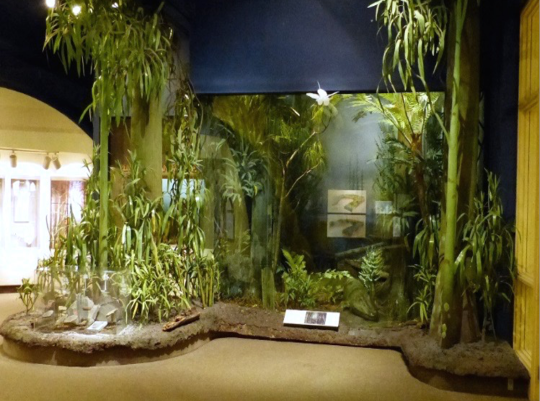
Figure 3.
In the 1940s, the 300-million-year-old Pennsylvanian age coal forest diorama was installed in a corner space of what is now part of the Benedum Hall of Geology (Fig. 3). Because coal converted to coke is a vital ingredient in steel production, this three-dimensional depiction of the conditions under which Pittsburgh’s economically important coal deposits formed was (and remains) an important public asset.
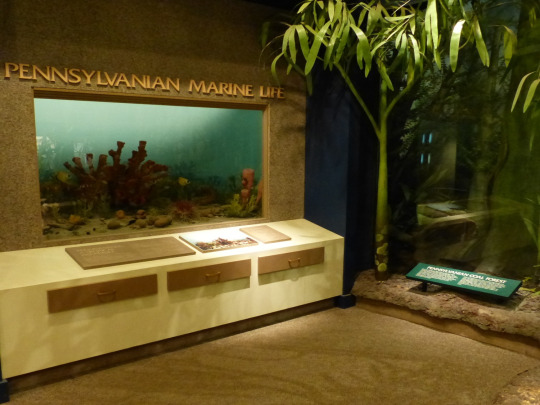
Figure 4.
In 1965, as part of an overall plan to bring more of the natural history museum’s fossil collection to the public, Paleozoic Hall opened with funding from the Richard King Mellon Foundation¹⁰. This exhibition featured nine dioramas that recreate the ancient environments through 290 million years of Earth history. Sadly, only one of the nine units remains on display, the diorama depicting the Pennsylvanian age marine seaway (Fig. 4), in the Benedum Hall of Geology.
Since the Benedum Hall of Geology opened to the public in 1988 the exhibition has featured an economic geology component with displays explaining differences between coal ranks Lignite coal to anthracite coal, and a variety of Pennsylvania’s crude oils and lubricants processed from the historic well Edwin Drake drilled in Titusville in 1859 (Fig. 1 )¹¹.

Figure 5.
Today, the Hall’s “strata wall,” a towering depiction of some of the rock layers found thousands of feet below western Pennsylvania, is in my opinion, an under-utilized display in terms of conveying information about fossil fuels. Although the wall is not currently documented with any geologic information, minor changes might allow visitors to use the lens of rock strata to better understand historical events such as the Drake Well, and economically important geologic reservoirs such as the Marcellus Shale (the second largest gas deposit in the United States), the natural gas storage reservoir of the Oriskany Sandstone, and the gas and liquid condensate (ethane) extracted from the Utica Formation (Ordovician Age) for making plastic products at the Shell Cracker Plant in Beaver County, PA (Fig. 5).

Figure 6.
Elsewhere in the museum, visitors can learn more about the topic of fossil fuels at several other locations. At the Holzmaden fossil exhibit in Dinosaurs in Their Time, there is a large fossil crinoid preserved in a dark gray limestone of Jurassic age, that represents a reservoir of crude oil in Germany (Fig. 6). At the mini diorama of the La Brea tar pits, oil seeps from natural fractures from an approximately six-million-year-old rock of Miocene age, to the unconsolidated surface sediment in what is now part of the City of Los Angeles (Fig. 7).

Figure 7.
Looking for Fossil Fuel Evidence in Art
In 2018, I reviewed 58 landscape paintings and the John White Alexander wall murals on the first and second floors of the Grand Staircase within Carnegie Museum of Art (CMOA) galleries to look for artistic documentation of what I interpreted to be causes for climate change based on the science. I found many examples based on the use of coal as a fossil fuel for power and coking in steel mills and the natural formation of bio-methane as portrayed in ecosystem landscapes of the industrial age of the middle 19th and early 20th century¹².
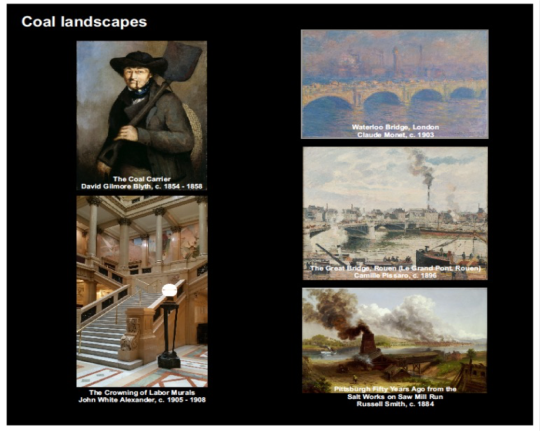
Figure 8.

Figure 9.
Searching for the CMOA landscapes paintings takes a little patience, but the visitor is rewarded by taking a new look at some of the art museum’s classic paintings (Fig. 8 and 9).
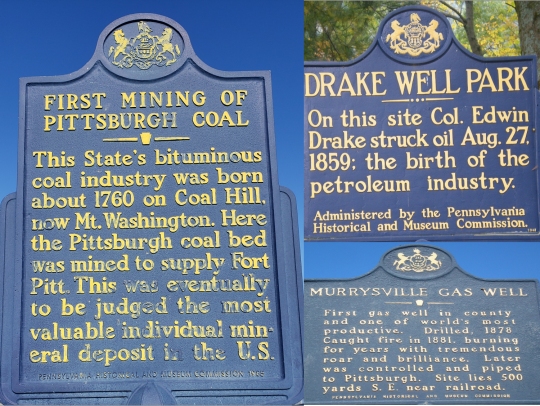
Figure 10.
Within day trip visiting distance of Carnegie Museums are historic plaques highlighting the discovery of coal on Mount Washington, natural gas in Murrysville, and oil in Titusville, Pennsylvania. (Fig. 10). At all three stops you’ll have a better understanding of the significance if you begin your investigation of fossil fuels at Carnegie Museums.
Albert D. Kollar is the Collection Manager for the Section of Invertebrate Paleontology. Suzanne Mills is the Collection Assistant and Joann Wilson is a volunteer Section of Invertebrate Paleontology.
References
1. Kollar, A.D. 2020. CMP Travel Program and Section of Invertebrate Paleontology promotes the 125th Anniversary of the Carnegie Library of Pittsburgh with an outdoor walking tour. https://carnegiemnh.org/125th-anniversary-carnegie-library-of-pittsburgh-outdoor-walking-tour/
2. Personal communications Anthony J. Young, Vice President (FP&O) Carnegie Museums of Pittsburgh.
3. Brezinski, D. K. and C K. Brezinski. 2014. Geology of Pennsylvania’s Coal. PAlS Publication Number 18.
4. Geology of the Marcellus Shale. 2011. Brezinski, D.K., D. A. Billman, J.A. Harper, and A.D. Kollar. PAlS Publication 11.
5. https://www.bloomberg.com/news/articles/2021-05-03/coal-consumption-in-the-u-s-declines-as-natural-gas-solar-wind-energy-rise
6. United States Energy Agency (EIA) 2019.
7. Bill Gates. 2021. How to Avoid A Climate Disaster.
8. Kollar et al. 2020. Carnegie Institute Extension Connemara Marble: Cross-Atlantic Connections Between Western Ireland and Gilded Age Architecture in Pittsburgh, Pennsylvania. ACM, 86, 207-253.
9. Dawson, M. R. 1988. Benedum Hall of Geology. Carnegie Magazine, 12-18.
10. Eller, E. R. 1965. Paleozoic Hall. Carnegie Magazine, 255-338.
11. Harper and Dawson 1992. Benedum Hall-A Celebration of Geology. Pennsylvania Geology, 23, 12-15.
12. Kollar et al. 2018. Geology of the Landscape Paintings at the Carnegie Museum of Art, a Reflection of the “Anthropocene” 1860-2017. Geological Society of America, Abstracts with Programs, v. 49, 243.
33 notes
·
View notes
Text
I Loved Him... Once - CH 1
Title: I Loved Him... Once
Author: jiminthestreets-bonesinthesheets
Fandom: Criminal Minds
Pairing: Heid (Aaron Hotchner x Spencer Reid)
Rating: This ones General but eventually as the series goes it will be Explicit
Tags: canon typical violence and gore, eventual smut as the series goes, angst, fluff, pining., its gunna be a slow burn guys.
Summary: A series following the team as they solve crimes and take down the bad guys.
In Part one of this series, we follow the team as they take down a serial killer that has taken a piece of one of their own. And through it all, Spencer and Hotch come to a few conclusions and realizations of their own.
AO3 Link
Masterlist
*** My works are not to be posted on any sites without my permission! But comments and reblogs are love! <3 Please and thanks!!
~~~~~~~~~~~~~~~~~~~~~~~~~~~~~~~~~~~~~~~~~~~~~~~~~~~~
Chapter 1
Spencer:
“What we have done for ourselves alone, dies with us. What we have done for others and the world remains and is immortal.” - Albert Pike
~~~~~~~~~~~
“Fourteen days, fourteen days, fourteen glorious days!”
Spencer barely looked up from the book he was reading, sat at his desk, leaning back in his desk chair as Derek Morgan sashayed across the bullpen and perched himself on the corner smiling down at him.
He opted to ignore the over the top, ray of sunshine, mood Derek was in, and flipped the page of his book. Derek was not giving in, he was not going to be ignored when he was in such a good mood, so he swiftly swooped his hand and stole Spencer's book, eliciting a whine of protest as he sat forward and reached for it. Though he didn't make any more effort than that, he knew very well there was no way he would be able to get the book back from Derek through force.
“Come on, Morgan, give it back.”
Derek laughed, his eyes shining with mirth as he kept playing keep away with Spencer, “You really want it back that bad?”
“Yes, actually, it was just starting to get good!” He made another jolt forward to reach for the book but it was in vain. Spencer’s brain might be fast, but Derek Morgan's reflexes were always faster.
“Really, kid, you're reading…” He turned the book over and eyed the title with a raised brow, “‘The Art of War’. You planning on taking someone down, Reid?” Spencer just eyed him as he closed the book and tucked it under his crossed arms, knowing full well that the genius would remember not only the page number he had been on before Derek closed the book, but the exact word he had read last. “Now, like I said before, we have fourteen, I repeat, fourteen glorious days of vacation starting right now. And you're telling me that your only plans are to sit here at your desk, at work, and continue reading ‘The Art of War’ instead of going out and doing something, anything, other than that?”
“It never hurts to educate yourself, Morgan, and yes, that's exactly what I'm telling you,” he replied, a little short, then tried once more to swipe unsuccessfully for his book, “now give me back my book.”
“Good god, man, live a little, you're killing me.” Derek stood and moved the book even further out of Spencer's reach, so he just huffed and sat back in his chair again. “You don't have any plans? No dates? No trips to exotic lands to meet fine exotic ladies?”
“When have you ever known me to ever have plans? Or dates for that matter. It's not like girls are exactly lining up to date the lanky, boy genius.”
“Oh you're much more than that, pretty boy, you know that.” Morgan perched himself on the side of his desk again.
“Not to mention the fact that seeing this in a bathing suit on a beach full of, more than likely, gorgeous people, is not something that is on anyone's bucket list, I'm positive of that. I'm so white I'd probably end up blinding half the beach with my legs alone.”
Derek was laughing, near tears at this point, “Oh, come on kid, it can't be that bad.”
“Oh, it is,” Spencer was slightly laughing at this point too, “I went to a pool party once in university and I was asked to put my shirt back on because the light was reflecting off my skin and ‘hurting people's eyes’... Derek, it was ten at night. My skin was reflecting the pool lights so severely it was hurting people.”
Derek barked out a laugh so hard he nearly fell off the table and Spencer couldn't help but join him. “So you just need a little bit of sun, cancel out some of the white. Why not come with me to Barbados? Little sand, little sun, and a whole lotta’ fun.” He shot a quick wink at Spencer who just scoffed and looked away. “Give me two days with you on the beach and I guarantee I could get you a couple shades darker, at least.”
“Oh, yes,” he nodded, smirking, “as well as skin cancer.”
“I promise I won't let you get skin cancer, but that being said, once we get you all sunkissed and confident, I can't promise I'll be able to keep all those fine ladies off of you.”
“You're not making this sound any better. Skin cancer, STD’s, and multitudes of random women hanging off of me, no thank you.”
“Well, if you don't want to be swarmed by the fine exotic women,” he paused, smirking down at a waiting Spencer, “I'm sure I can help you land some handsome exotic men, then. I'm not here to judge. More women for me.”
Spencer reached to the side and grabbed the small pile of papers that were sitting there, and swiftly smacked Derek on the arm with them, “Get off my desk.”
“That doesn't sound like a denial,” he ducked as he was swatted at again, “come with me and I promise you'll have a good time.”
“Go!”
Derek chuckled once more, before ducking under his own desk to grab his bag, then turned back to toss the book back to Spencer who barely caught it, “My flight doesn't leave till tomorrow night, think about it!”
“I don't need to, I'm not going!”
“Think about it!”
“What's the point anyways!?” He called as Derek was almost out of ear shot, but he continued anyways, “When has vacation ever worked out for us? I'd buy a ticket and pay for a room, and realistically we'll probably end up right back here in two days, four tops!”
Derek was gone by this point, not having heard most of what he had said, more than likely already knowing that this was probably their reality, but not wanting to have to accept it. Though his complaints didn't fall on deaf ears.
“Oh, now you've gone and jinxed it. Just know that if our vacation gets cancelled due to a case, I am definitely coming after you first, Reid.”
He gazed up at Emily over the edge of his book, having indeed remembered the exact word he had left off on when it was stolen from him, and gave her a playful smirk. “I am only stating statistics. If you factor in every vacation we have had since we started here at the BAU, the odds that we will have a full, uninterrupted ‘fourteen glorious days’ as Morgan put it, are less than ten percent. Eight point five-six-three-two percent to be exact.”
“God I hate you sometimes,” though she laughed as she said it, “so you really don't have any plans?”
“I never said I didn't have any plans,” he sighed and closed his book on his desk, resigned to not getting any reading done until everyone was gone, “just because I don't have plans involving a hot beach or women, doesn't mean I don't have plans.”
“Oh!” She perked up and moved closer, intrigued. “So what kinds of fun are you up to then?”
“Oh, loads!” He shifted in his chair, moving to lean towards her with his elbows on his desk. “I'm signed up for a lecture series that starts tomorrow, but the one I'm most excited for is a lecture called ‘Synthetic Metals: A Novel Role For Organic Polymers’ presented by Dr. Alan G. MacDiarmid. It's a Nobel lecture all about possible engineering applications for, and the inner workings of, organic and conductive polymers. It sounds completely fascinating! I was also thinking of taking a trip to Colonial Williamsburg. I mean, how amazing would it be to walk the same streets as Thomas Jefferson, or eat in the same place as George Washington! I was also thinking of visiting the Virginia Museum of Fine Arts. They have over twenty- two thousand works on display that are largely focused on modern and contemporary art, especially with a focus on European art after the nineteen hundreds. They are also having a workshop there next week focusing on-”
“Woah, woah, take a breath,” she laughed a bit, then asked with a hint of concern, “aren't you doing anything that doesn't involve… learning? Like, no info intake, no lecture series, no workshops, just relaxing? Letting your brain just take a break?”
Spencer pouted his bottom lip in thought then looked back up to Emily, “No? Why would I want to waste two weeks doing nothing when I could spend them increasing my knowledge?”
“Wouldn't you want to sit back and…” She stared confusedly at an equally confused Spencer, then just shook her head with another laugh, “Nevermind, look who I’m talking to. Of course you would think that spending two weeks learning would be an ideal vacation. To each their own I guess, right.”
He just nodded, picking his book up again as she moved away from his desk.
“Well, have fun with your jam packed knowledge filled two weeks, see you in fourteen days.”
“Or in two to four days. Don't forget the eight point five-six-three-two percent chance that I will see you before-”
“Blah, blah, blah!” She covered her ears as she walked away from him, “Can't hear you, already on vacation!”
“Very mature,” though he was smiling, “have fun with your mother.”
She threw a quick wave at him then disappeared. When she was finally gone, he sat back in his chair with a content sigh. Now that Emily was gone, it was just himself, Rossi, and Hotch who were left in the office, and he knew there was a very low chance that either of them would interrupt him to inquire about his vacation plans. He was finally able to finish his book in peace before catching the last train home.
~~~~~~~~~~~
“Knock, knock.”
Aaron looked up from where he had been bent over the front of his desk, the pile of papers he had been sorting through covering every inch of it, and towards the door. “David, come in.”
The man did, eyeing the mess, but merely stood in the middle of the room and tucked his hands into the pockets of his very expensive suit. “Always one of the last to leave, huh?”
“Has everyone gone?” Aaron asked without looking up this time.
“Everyone except the usual suspect.”
“Reid.” Aaron sighed. ‘Not last to leave,’ he thought. Spencer always seemed to still be there, even in the late late hours of the night. After a case, before vacation, even sometimes during vacation. Aaron always felt bad for the man, worried that he was lonely, though nowadays he could relate.
“I overheard him talking with Emily and Derek before they left. His most exciting plans seem to have something to do with a Nobel lecture series,” Rossi moved closer, taking up the chair in front of Aaron’s desk, “that kid needs to learn how to slow down and relax, I'm worried he might burn out someday if he doesn't. He should go out, have some fun from time to time.”
“Well I'm not much better,” Aaron turned, leaning against his desk with his arms crossed, now facing David, “my plans for the next two weeks pretty much consist of staying home, catching up on more paperwork, and if I can swing it with Haley, taking Jack for a few days. If I play my cards right, the park will be the most exciting adventure of my vacation. I'm not exactly going out to paint the town red either.”
“Yeah, you two are wild,” he drawled with a smirk, “you know, maybe a date would do the kid well. Loosen him up a bit.”
Aaron eyed him warily with a tilt of his head, seeing right through his attempted ruse, “What exactly are you suggesting?”
“Perhaps, while you both have the time off, you and Spencer could plan something together.” Aaron closed his eyes with a sigh and shifted, opened his mouth to say something in protest, but David beat him to it, hands up to stop him. “I'm just saying, you're the only two people on the team that aren't out of town for the next two weeks. I’ll be in Italy visiting family, JJ is taking her family camping, Prentis is visiting her mom, Garcia is, quote, ‘on a shopping tour of all the best malls in the northern hemisphere’, and Morgan is hitting the beach in Barbados. That leaves you and Reid. So all I'm saying is that maybe you can stop fantasizing about the kid and actually do something about your infatuation.”
Aaron just gaped at his friend, shocked, speechless for the first time in as long as he can remember. “I… how…” Was the only thing he was able to manage to stutter out.
David just smiled up at him mischievously and stated, “I'm a profiler, Aaron, and a damn good one. I've seen the way you look at Spencer, the way you stick close to him, and it's very obvious you care about him. It doesn't take a genius to figure it out, yet ironically the only one to not have figured it out yet is the only actual certified genius.”
Aaron still didn't know what to say. He had never told anyone about how he felt about Spencer. It was hardly appropriate for him to attempt to pursue the man considering he was his superior, not to mention older than him. Something that had plagued him since the very day he met the cute, quirky doctor on his first day with the BAU.
“I can tell you're over-thinking, Aaron.” Rossi speaking brought him out of his small internal panic and he looked down at him. “What is it? That you're his boss? Strauss?”
He shifted, crossing his arms impossibly closer to his chest. No point in denying it now. “A bit of both, I guess. Not to mention the age difference between us.”
“First off, I wouldn't worry about Strauss. If anything were to happen between you and Spencer, as long as you navigate the correct channels and immediately disclose your relationship, sign the proper papers, then there is nothing Strauss can do against either of you or your jobs. As for you being his superior, I wouldn't even give that a second thought. No one on our team would think anything of it, no one would ever even entertain the thought that you took advantage, and neither would Spencer.” David then leaned forward, resting his elbows on his knees as he spoke. “And the age gap, who cares. Love, is love, is love. Take it while you've got it and don't ever let it go. Age is but a number and love knows no bounds.”
“Very profound of you, David.” He couldn't help but let a small chuckle slip.
“What can I say, I am the embodiment of love.”
“Right, and is that why you've been married three times and are on wife number four?”
They both laughed, hearty and full, and for the first time since they started talking, Aaron found himself feeling a lot lighter. It was nice to finally have someone who knew his secret feelings for the young genius, and be able to actually have someone to talk to and confide in about it.
Rossi's phone ringing broke the moment though, and he reached into his pocket, just looking at the screen and not answering. “Well, my ride to the airport is here. I will see you in two weeks, do not call me.”
Aaron let loose one last light chuckle, moving along with Dave to see him out. With a smile and a pat on the back as they reached the door he said, “I'll try not to, enjoy your time in Italy.”
“Oh I intend to,” he opened the door, then turned back at the last minute, “but do me a favor will ya. Don't call me, but do call Spencer.”
Aaron just smiled, gave Dave a small push out the door, and answered, “Good bye, David.”
Once he was out the door and down the stairs, Aaron closed the door and took a step to the side to watch him cross the bullpen. He gave a quick goodbye to Spencer as he passed, and then he was gone. Then his eyes wandered over to the last person left besides himself, still sitting alone at his desk, leaned back reading his book. He sighed, watching Spencer for a moment longer before thinking to himself, maybe David was right. Why should he worry about all that other nonsense? Besides, he would never know if Spencer felt the same unless he asked.
~~~~~~~~~~~
Aaron finally finished organizing the paperwork explosion on his desk, filing away what was finished and adding the rest to his bag, then was finally able to head out.
It had been a good two hours since Rossi had left his office, leaving Aaron with all kinds of things to think about, and the man that those thoughts were all about was still sitting in the same spot he had been in since vacation officially began. Though now, Spencer was already halfway through his second book.
As he passed him, the younger man not even so much as lifting his eyes from his book, he said a quiet, “Have a good vacation, Reid.”
“You too, Hotch,” he answered back, and Aaron just about kept walking, but stopped himself at the last minute and turned back.
They were currently alone, no one else around but him and Spencer, so now was just as good a time as any. “Reid…”
At the questioning tone to his name, Spencer looked up at Hotch who was now standing right in front of him, “Yeah?”
“I… I was…'' Spencer was still looking up at him with concerned eyes, a furrowed brow, and if Aaron was being honest, a super cute frown. Now, what Aaron wanted to say was ‘Spencer, I know that you and I are the only two who will be remaining in town for the duration of our vacation time, and I was wondering perhaps, if you would like to take advantage of the fact and allow me to take you out to dinner tomorrow night?’ But what he actually managed to come out with instead, was a sad and defeated, “I… I just wanted to wish you well. I hope you have a good fourteen days, and I heard you will be attending a lecture series, I hope it's informative.”
“Right…” Hotch couldn't be certain, but he was sure that Spencer almost looked… disappointed? “An-anything else?”
“... No, I don't believe so.” And before he could stumble his way through any more embarrassing sentences he quickly said, “Good night,” and left before Spencer could even return the sentiment. Leaving him staring, still confused and a little down, after a fast walking Aaron, not having the courage to even look back as he left.
~~~~~~~~~~~
Derek woke for the first time well rested and relaxed. No case to solve, no unsub on his mind, no high speed chase down unfamiliar roads, and no showdown with a psychopath in some dark abandoned warehouse. It was just him, the sun, the sand, and two weeks of relaxing and sleeping late, eating more than he probably should and shoving as much fun into two weeks as was completely possible.
Now, those were Derek's original plans. The plans he made before he left Quantico, Virginia for the beaches in Barbados. For the all night parties, the beautiful ladies, and the all inclusive never ending free drinks. And yet, here he found himself, within arm's reach of all those things, and not doing a single one of them.
Instead, Derek walked down the beach and found an empty lounge chair tucked under a very colourful umbrella. A sprite and lime with ice in hand, he stood and looked out at the calming ebb and flow of the ocean, letting the soft crashing of the waves take over and clear his mind completely. It was nice, the best he'd felt in a long, long time.
A volleyball skid to a halt at his feet, covering his toes in warm sand, caught his attention and he turned to face the small group of women off to his side. He kicked the ball back over to them, each one of them very obviously interested in getting to know Derek, even if it were just for one night. But to his own surprise, he found himself flashing a smile and a wave in decline of their invitation to come play, and instead took up his seat in the covered lounge chair.
He took a second to breathe in the fresh air, took a sip of his drink, then reached down to the small bag he had tucked under the chair, rifling through until he found what he was looking for. He settled back in the chair, not able to help the smile that spread across his face as he read the title of the book in his hands, 'The Art of War', and settled back to read it with a quietly muttered, "Damn you, Spencer Reid."
~~~~~~~~~~~
A/N: So there is chapter 1, chapter 2 to come soon! I’m super excited about this guys XD
And if anyone wants to be tagged for future updates please let me know <3
#Criminal Minds#aaron hotchner#spencer reid#Spencer x aaron#spencer reid x aaron hotchner#reid x hotch#hotchner x reid#spencer/aaron#spencer reid/aaron hotchner#reid/hotch#emily prentiss#jj#Jennifer Jareau#david rossi#derek morgan#Penelope Garcia#smut#fluff#angst#pining#slow burn#canon typical#part one#criminal minds fanfiction#criminal minds fic#criminal minds fanfic#heid#heid fic#spencer reid x aaron hotchner fic#spencer x reid fic
12 notes
·
View notes
Text
Fashion history museums and collections

Dear historically interested internet,
Apparently I’m not busy enough with the summer semester start online, so I did what I usually do: I spend a shitload of time researching. This time, there’s three other research lists I want to start with you first, as these are where I’ve found many of the museums I want to put into your corontine-bored hands today. The wonderful photos of the MET in NY, the national history museum of the UK, the Louvre and the Victoria and Albert museum were taken from free photos website https://pixabay.com/. Research lists for fashion history as I put together are floating around the internet numerously. Karolina Zebrowska did a wonderful video on where to learn about fashion history, and she gave a variety of media to comb through in the video description. Much thanks to her, it’ll take a while to go through all of it. Two actual lists on fashion and design museums like this one that Karolina Zebrowska included are this one and this one. Now, such far-buried blog posts and articles are a) hard to find and b) have a habit of being deleted, outdated or vanishing from the surface of the internet for other reasons, so I decided to go through them and save the museum pages sorted by region. Therefore, all credit for the existence of this tumblr post ultimately goes to Karolina Zebrowska and the admirable people who put together these two lists. Please go check out her video, she did much, much more than listing museums.
So, here we go:
Museum collections of fashion history, textiles and design
United Kingdom
Victoria and Albert Museum for art and design in London National Museum of Scotland, art and design Bath Fashion Museum Manchester Art Gallery
Europe
Swedish digital museums Kyoto digital archives Spanish Costume Museum, in Spanish only Museé Yves Saint Laurent Paris, in French only Rijkstudio: Photo collection of the Rijksmuseum in the Netherlands
Historical museum of Frankfurt, fashion history collection in English Stadtmuseum Berlin in English, mainly for paintings and appled arts Fashion history collection of the Museum für Kunst und Gewerbe Hamburg in English Fashion, textiles and costume collections of the Stadtmuseum München (Munich) in English
USA The MET museum New York online and related to this MET museum tours 360° The New York Public Library online Fashion Institute of Technology in New York and Their fashion collections Smithsonian Design Museum Smithsonian National Museum of American History Drexel University Westphal College of arts&design, historic fashion collection Los Angeles fashion institute of design & merchandizing (FIDM) M. H. de Young Memorial museum of fine arts in San Francisco, costume and textile arts department Henry Art gallery of the university of Washington George Washington university Museum Museum of fine arts of Boston, David and Roberta Logie Department of Textile and Fashion Arts Newportal museum, Rhode Island Newfields museum of nature & art University of New Hampshire, Irma G. Bowen historic clothing collection Kent state university, Gallery of costume Los Angeles County Museum of Art, collections Philadelphia Museum of Art Royal Ontario Museum Texas Fashion Collection The Valentine: Richmond, Virginia
Otherwise English-speaking:
Textile Museum of Canada Museum of New Zealand
That’s it for now, of course one could make this list double or triple the length. Clicking through gorgeous museum pieces gives me personally a certain feeling of peace in this trying times, and I wish you the same. Whether you’re searching for original pieces for writing reference, out of sheer interest or just for fun, enjoy the work of many many museum staff employees put together on these websites. Stay safe!
38 notes
·
View notes
Text
Teknik Aliran Kesadaran dalam Fiksi

Teknik aliran kesadaran atau yang lebih dikenal dengan stream of consciousness adalah teknik bercerita naratif yang menggambarkan pikiran dan perasaan yang melintas dalam diri tokoh. Digagas pertama kali oleh William James pada tahun 1980 dalam The Principles of Psychology. Pada tahun 1918, May Sinclair, penulis asal Inggris, pertama kali menerapkan istilah ini dalam konteks sastra saat membahas novel Pointed Roofs (1915) karya Dorothy Richardson. (sumber: tirto.id)
Salah satu pengarang yang terkenal karena menggunakan teknik ini adalah Virginia Woolf. Dalam Mrs. Dalloway dan To the Lighthouse, Woolf masuk ke dalam karakter buatannya dengan menggunakan teknik ini. Aliran kesadaran memungkinkan pengarang menggerakkan cerita mengikuti alur pikiran perasaan si tokoh tanpa batasan. Jika dibaca, penggunaan aliran kesadaran membuat tulisan terasa lebih intens, mengikat dengan sensasi panca indra yang kental. Seperti membaca buku harian yang bukan sekadar bercerita, tetapi juga bergerak mengikuti alur.
Kedengaran menarik?
Pertama kali membaca karya Virginia Woolf, saya langsung terpikat oleh gaya bercerita beliau. Sangat intens. Terasa seperti diayun dalam mimpi dengan pemilihan kata-kata magis yang menakjubkan. Ciri-ciri penggunaan aliran kesadaran ini di antaranya: seperti monolog (percakapan dengan diri sendiri); munculnya pikiran tokoh; minimnya penggunaan tanda baca, kalimat yang panjang-panjang mengikuti pikiran si tokoh; jika si tokoh sedang kacau, maka kacau pula aliran narasinya; ada perjalanan waktu ke masa lalu dan masa kini; terkadang sulit dimengerti karena memungkinkan untuk dibaca cepat tanpa penjelasan detail; sulit dipertanyakan karena setiap detailnya merupakan kepingan pikiran si tokoh dan perlu dianalisis lebih keseluruhan untuk bisa dipahami; cenderung melompat-lompat.
Berikut saya lampirkan beberapa contoh dari narasi aliran kesadaran:
James Joyce - Ulysses.
"Dia adalah Leopold muda, seperti dalam pengaturan retrospektif, cermin di dalam cermin (hei, presto!), Dia melihat dirinya sendiri. Coba ini terlihat, gagah, berjalan pada pagi yang menggigit dari rumah tua di Clambrassil ke sekolah menengah, bukolier yang sedang berjuang, dan diuraikan menggunakan roti gandum yang bagus, pikir seorang ibu."
Virginia Woolf - Mrs. Dalloway.
"Apa yang sangat! Apa yang jatuh! Karena itu selalu terasa bagiku kompilasi, dengan sedikit mencicit engsel, yang bisa kudengar sekarang, aku membuka jendela Prancis dan menjatuhkan Bourton ke udara terbuka. Betapa segar, tenang, lebih tenang dari ini tentu saja saja, udara di pagi hari; seperti kepakan ombak; ciuman ombak; kedinginan dan tajam, namun (sungguh-sungguh) sungguh-sungguh, sungguh seperti saya, terangkat di sana di jendela yang terbuka, apa saja yang akan terjadi. .. "
David Lodge - British Museum is Falling Down.
"Itu mengambil, berpikirnya, menggeser bobotnya di pelana, metempsikosis, cara melepaskan yang mudah jatuh ke dalam cetakan yang dipersiapkan oleh literatur. Atau apakah itu, ia bertanya-tanya, mengupil, menuntut dengan saksama struktur kalimat para novelis Inggris? Lagi-lagi orang mengundurkan diri untuk tidak memiliki bahasa pribadi lagi, tetapi orang lain berpegang teguh pada ilusi properti pribadi dari peristiwa. Sebuah ilusi yang menemukan dan tidak membuahkan hasil, mengundang, karena di sini, tak terelakkan datang limusin, dengan Tokoh Sangat Penting, atau Tokoh-Tokohnya, terlihat samar-samar di interior.Polisi memberi hormat, dan kerumunan mendesak maju, berbisik, 'Philip', 'Tony', 'Margaret', 'Pangeran Andrew'. "
Teknik ini banyak melenggunakan persepsi. Sangat cocok jika kamu menginginkan penggambaran karakter kompleks yang kuat. Aliran kesadaran membuat pembaca seolah menyelam sendiri ke dalam kerumitan pikiran dan perasaan si tokoh. Segala cacat, cela, kebaikan si tokoh akan terasa seolah milik pembaca sendiri.
Selain itu, roh cerita akan sangat bergantung pada tokoh. Elemen cerita lain seperti latar, alur, dsb dinilai berdasarkan kacamata sang tokoh yang menjadi narator. Baiknya, teknik ini akan membuat cerita terasa alami dan mengalir apa adanya.
Mengutip Putu Wijaya: "Hal terpenting dalam bercerita adalah menceritakan apa yang ada di kepala, bercerita nyerocos apa adanya. Kalau tidak tahu, ya tidak tahu. Kalau memang bodoh, ya biar bodoh, tak usah dipintar-pintarkan. Justru dengan sikap demikian cerita dapat mengalir ke mana dan di mana saja tanpa terbebani keharusan untuk menetapkan adanya rujukan yang pasti tentang segala hal yang diceritakan."
Teknik aliran kesadaran, seperti yang sudah dijelaskan di awal, merupakan teknik psikologi. Mengutip Sigmund Freud: "Keadaan manusia sebenarnya bukan hanya kesadaran, yang lebih penting justru ketidaksadaran." Teknik ini sangat bagus untuk menunjukkan mental karakter tanpa terkesan berlebihan.
Ada beberapa cara yang bisa teman-teman pakai jika ingin menggunakan teknik ini (text.id): teknik montase, kolase, dan asosiasi.
Montase: memilih gambar putus-putus dan menyambungnya menjadi satu kesatuan.
Kolase: menempelkan potongan-potongan kutipan dari karya lain, ungkapan asing, dll; cerita terputus oleh kisah yang biasanya dianggap tidak berhubungan dengan cerita.
Asosiasi: penampilan peristiwa-peristiwa yang sepertinya tidak berkaitan dengan inti cerita tetapi sebenarnya bertautan.
Beberapa novel yang menggunakan teknik aliran kesadaran:
Mrs. Dalloway (Virginia Woolf)
To the Lighthouse (Virginia Woolf)
The Waves (Virginia Woolf)
Catatan dari Bawah Tanah (Vyodor Dostoyevsky)
Suisho Genso (Yasunari Kawabata)
The Stranger (Albert Camus)
The Sound and The Fury (William Faulkner)
The Catcher in the Rye (J.D Salinger)
Ulysses (James Joyce)
The Great Gatsby (F. Scott Fitzgerald)
On the Road (Jack Kerouac)
Hunger (Knut Hamsun)
The Bell Jar (Sylvia Path)
Anna Karenina (Leo Tolstoy)
Tropic of Capricorn (Henry Miller)
Tertarik mencoba teknik ini?
1 note
·
View note
Text
Events 3.18
37 – Roman Senate annuls Tiberius' will and proclaims Gaius Julius Caesar Augustus Germanicus (aka Caligula = Little Boots) emperor. 1068 – An earthquake in the Levant and the Arabian Peninsula leaves up to 20,000 dead. 1229 – Frederick II, Holy Roman Emperor, declares himself King of Jerusalem in the Sixth Crusade. 1241 – First Mongol invasion of Poland: Mongols overwhelm Polish armies in Kraków in the Battle of Chmielnik and plunder the city. 1314 – Jacques de Molay, the 23rd and final Grand Master of the Knights Templar, is burned at the stake. 1438 – Albert II of Habsburg becomes King of the Romans. 1571 – Valletta is made the capital city of Malta. 1608 – Susenyos is formally crowned Emperor of Ethiopia. 1644 – The Third Anglo-Powhatan War begins in the Colony of Virginia. 1673 – English lord John Berkeley sold his half of New Jersey to the Quakers 1741 – New York governor George Clarke's complex at Fort George is burned in an arson attack, starting the New York Conspiracy of 1741. 1766 – American Revolution: The British Parliament repeals the Stamp Act. 1793 – The first modern republic in Germany, the Republic of Mainz, is declared by Andreas Joseph Hofmann. 1793 – Flanders Campaign of the French Revolution, Battle of Neerwinden. 1834 – Six farm labourers from Tolpuddle, Dorset, England are sentenced to be transported to Australia for forming a trade union. 1848 – The premiere of Fry's Leonora in Philadelphia is the first known performance of an grand opera by an American composer. 1848 – March Revolution: In Berlin there is a struggle between citizens and military, costing about 300 lives. 1865 – American Civil War: The Congress of the Confederate States adjourns for the last time. 1871 – Declaration of the Paris Commune; President of the French Republic, Adolphe Thiers, orders the evacuation of Paris. 1874 – Hawaii signs a treaty with the United States granting exclusive trade rights. 1898 – Phoebe (moon), a satellite of Saturn, becomes first to be discovered with photographs, taken in August 1898, by William Henry Pickering. 1902 – Macario Sakay issues Presidential Order No. 1 of his Tagalog Republic. 1913 – King George I of Greece is assassinated in the recently liberated city of Thessaloniki. 1915 – World War I: During the Battle of Gallipoli, three battleships are sunk during a failed British and French naval attack on the Dardanelles. 1921 – The second Peace of Riga is signed between Poland and the Soviet Union. 1921 – The Kronstadt rebellion is suppressed by the Red Army. 1922 – In India, Mohandas Gandhi is sentenced to six years in prison for civil disobedience, of which he serves only two. 1925 – The Tri-State Tornado hits the Midwestern states of Missouri, Illinois, and Indiana, killing 695 people. 1937 – The New London School explosion in New London, Texas, kills 300 people, mostly children. 1937 – Spanish Civil War: Spanish Republican forces defeat the Italians at the Battle of Guadalajara. 1938 – Mexico creates Pemex by expropriating all foreign-owned oil reserves and facilities. 1940 – World War II: Adolf Hitler and Benito Mussolini meet at the Brenner Pass in the Alps and agree to form an alliance against France and the United Kingdom. 1942 – The War Relocation Authority is established in the United States to take Japanese Americans into custody. 1944 – Mount Vesuvius in Italy erupts, killing 26 people, causing thousands to flee their homes, and destroying dozens of Allied bombers. 1948 – Soviet consultants leave Yugoslavia in the first sign of the Tito–Stalin Split. 1953 – An earthquake hits western Turkey, killing 265 people. 1959 – The Hawaii Admission Act is signed into law. 1962 – The Évian Accords end the Algerian War of Independence, which had begun in 1954. 1965 – Cosmonaut Alexei Leonov, leaving his spacecraft Voskhod 2 for 12 minutes, becomes the first person to walk in space. 1967 – The supertanker Torrey Canyon runs aground off the Cornish coast. 1968 – Gold standard: The U.S. Congress repeals the requirement for a gold reserve to back US currency. 1969 – The United States begins secretly bombing the Sihanouk Trail in Cambodia, used by communist forces to infiltrate South Vietnam. 1970 – Lon Nol ousts Prince Norodom Sihanouk of Cambodia. 1971 – Peru: A landslide crashes into Yanawayin Lake, killing 200 people at the mining camp of Chungar. 1980 – A Vostok-2M rocket at Plesetsk Cosmodrome Site 43 explodes during a fueling operation, killing 48 people. 1990 – Germans in the German Democratic Republic vote in the first democratic elections in the former communist dictatorship. 1990 – In the largest art theft in US history, 12 paintings, collectively worth around $500 million, are stolen from the Isabella Stewart Gardner Museum in Boston. 1994 – Bosnia's Bosniaks and Croats sign the Washington Agreement, ending war between the Croatian Republic of Herzeg-Bosnia and the Republic of Bosnia and Herzegovina, and establishing the Federation of Bosnia and Herzegovina. 1996 – A nightclub fire in Quezon City, Philippines kills 162 people. 1997 – The tail of a Russian Antonov An-24 charter plane breaks off while en route to Turkey, causing the plane to crash and killing all 50 people on board. 2014 – The parliaments of Russia and Crimea sign an accession treaty. 2015 – The Bardo National Museum in Tunisia is attacked by gunmen. 23 people, almost all tourists, are killed, and at least 50 other people are wounded.
1 note
·
View note
Photo



“Her loveliness thrills me to the core, whenever I call up the vision.” —Leslie Stephen
Julia Jackson would later marry Leslie Stephen; then become the mother of Virginia Woolf and Vanessa Bell.
'Julia Jackson', albumen prints 1864 and 1867 photographs by Julia Margaret Cameron Julia Stephen at the Bear Grindelwald, Switzerland, 1889 photography by Gabriel Loppé crédit: Victoria & Albert Museum, UK
#julia jackson#julia stephen#virginia woolf#mother#vanessa campbell#albumen process#1864#1867#england#leslie stephen#julia margaret cameron#gabriel loppé#1889#heavy curtain#intellectual family#intellectuals#distinguished#accomplished#family trees#victorian era#culture#art#photography
4 notes
·
View notes